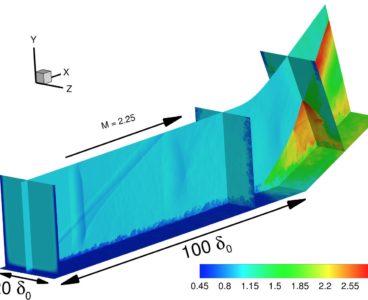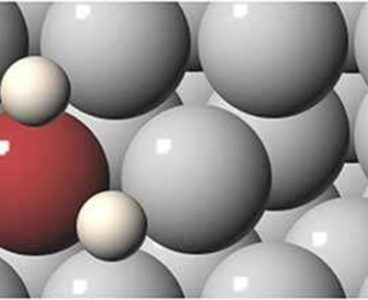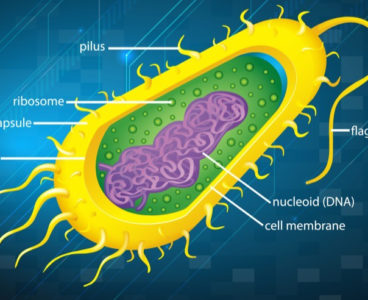A more efficient car engine? That’s the goal. An opposed-piston engine is more efficient than a traditional internal combustion engine. Pinnacle Engines is developing a multi-cylinder gasoline engine for automotive use. The team enhanced the engine’s reciprocating sleeve-valve system, thanks to a Department of Energy supercomputer. The result? An engine with better combustion and reduced…
Department of Energy to Provide $45M for Chemical and Materials Research in Quantum Information Science
Department of Energy to Provide $24 Million for Computer-Based Materials Design
Research Redefines Knowledge of Oxygen Binding on Graphene
Fuels, plastics, and other products are made using catalysts, materials that drive chemical reactions. To design a better catalyst, scientists must get the right atoms in the right spot. Positioning the atoms can be difficult, but new research makes it easier. Researchers determined the exact location of single oxygen atoms, which act like anchors for…
Department of Energy Announces $218 Million for Quantum Information Science
A Two-for-one Deal
Truly secure communications. No eavesdropping. That’s the promise of quantum communication. One challenge to making it a reality is light. We need an efficient way to create packets of light, called photons. Now, scientists have identified how modified carbon nanotubes emit photon pairs. The experiments and theory show that the photon pairs are the result…
Onion-like Carbon Material Reduces Friction
In 2015, a team from Argonne National Laboratory created a material with superlubricity (near-zero friction) at engineering scale. The material contained graphene and extremely small diamonds. The team replaced the graphene with molybdenum disulfide. The molybdenum disulfide causes a reaction that turns the diamonds into onion-like carbon. The result? A self-generating, very low friction dry…
The High-Tech Evolution of Scientific Computing
Science has always relied on a combination of approaches to derive an answer or develop a theory. The seeds for Darwin’s theory of natural selection grew under a Herculean aggregation of observation, data, and experiment. The more recent confirmation of gravitational waves by the Laser Interferometer Gravitational-Wave Observatory (LIGO) was a decades-long interplay of theory,…
Scientist Mines Supercomputer Simulations of Protein Dynamics for Biological Energy-Conversion Principles
An energy crisis can trigger years of fuel shortages and high gas prices. Energy shortages in biological cells are even more serious. Consequences include amyotrophic lateral sclerosis and aging-related disorders such as Alzheimer’s and Parkinson’s diseases. Living cells in plants employ so-called bioenergetics machinery – an array of interlinked chemical reactions that convert sunlight to…
Engineers Turn to Argonne’s Mira Supercomputer to Study Supersonic Turbulence
Aviation’s frontier is supersonic. The military is seeking ever-faster aircraft, planes that can fly five times the speed of sound. Fifteen years after the Concorde’s last transatlantic flight, Japan Airlines and the Virgin Group are investing in jets that could slash overseas travel time by more than half. But supersonic speeds bring a slew of design challenges.…
Shark Sense
Just like a shark, a new film detects minute changes in nearby electric fields while immersed in a harsh environment. The thin film contains samarium, nickel, and oxygen (SNO). When submerged in water and exposed to an electric bias, the film undergoes a reproducible and reversible change in its structure. That is, it incorporates protons…
Semiconductors Stretch Out to Become Perfect
Compressing a semiconductor to bring atoms closer together or stretching it to move them farther apart can dramatically change how electricity flows and how light is emitted. Scientists found an innovative way to compress or stretch very thin (monolayer and bilayer) films of tungsten diselenide by placing the film on different surfaces at high temperatures.…
“Active” Matter Powers Self-Propelled Fluid
With huge potential energy savings for technologies ranging from sensors to supercomputers, this new mechanism created self-propelling fluid with energy-harvesting machines. These machines were composed of filaments and molecular motors. For the first time, fluid with directionless flow autonomously flowed unidirectionally through meter-long 3-D channels until the chemical energy was depleted. The direction of the…
Cold Water Molecules Get in Line
Single-walled carbon nanotubes act like tiny straws that are so narrow that water confined within cannot freeze into its normal crystal-like structure. In particular, in very thin nanotubes, water molecules align in a single-file manner. At room temperature, each molecule remains orientated in a random direction, creating a disordered chain. For the first time, scientists…
Controlling Traffic on the Electron Highway—Researching Graphene
On an otherwise normal day in the lab, Eva Andrei didn’t expect to make a major discovery. Andrei, a physics professor at Rutgers University, was using graphite – the material in pencils – to calibrate a scanning tunneling microscope. As part of the process, she turned on a very powerful magnetic field. When she looked…
Quantum Computing Building Blocks
For decades scientists have known that a quantum computer—a device that stores and manipulates information in quantum objects such as atoms or photons—could theoretically perform certain calculations far faster than today’s computing schemes. But building the “parts” for a quantum computer is a monumental research task. One promising approach involves using the quantum “spin” property…
Nature of Optics Changes in Just One Step
Optical lenses that can see features smaller than the wavelength of light cannot be made from conventional materials. Creating “hyperlenses” that can take ultra-sharp images needs both designer materials (that is, metamaterials) and innovative optics to be developed. Current methods for fabricating such synthetic metamaterials are complicated and involve assembling artificial cells and patterning processes. …
Team Discovers Way to Make Alane a Better Hydrogen Fuel Option for Vehicles
Scientists at the U.S. Department of Energy’s Ames Laboratory, in collaboration with several partners, have discovered a less-expensive, more energy-efficient way to produce alane – aluminum trihydride – a hydrogen source widely considered to be a technological dead-end for use in automotive vehicles. Alane had earned its dead-end reputation for use in cars because making…
Examining the Failures of Light-Harvesting Semiconductors
While metal oxide semiconductors have been widely considered to exhibit outstanding durability, performance degradation in these solar energy harvesting components is frequently observed. Understanding the degradation is essential for developing stable, efficient photosystems. To address the failure, a team at the Joint Center for Artificial Photosynthesis uncovered the mysteries of photochemical instability in a widely…
High-Occupancy Vehicle Batteries on the Horizon
In lithium-ion batteries, a singly charged lithium atom (or “ion”) flows between two electrodes while one electron is contributed to the electrical current in the external circuit. If too many lithium ions are intercalated (inserted between existing atomic layers), the electrode’s atomic structure can distort, which usually limits the ability to recharge the battery. In…
Semiconductors Pave the Way for Next-Generation Electric Switches
Computers use switches to perform calculations. A complex film with “quantum wells” — regions that allow electron motion in only two dimensions — can be used to make efficient switches for high-speed computers. For the first time, this oxide film exhibited a phenomenon, called resonant tunneling, in which electrons move between quantum wells at a…
Graphene Rewrites the Rules of Engagement
In what could prove to be a significant advance in fabricating new technologies, scientists discovered a new self-assembly mechanism that surprisingly drives negatively charged molecules to clump together to form islands when graphene is supported by an electrical insulator. Under these conditions, different charge interactions are not diminished, as they are when graphene is supported…
Black Semiconductors Keep Things Cool
As anyone who has held a laptop computer or cell phone knows, they produce heat that has the potential to damage the microchips inside. However, layered, crystalline black phosphorus could lead to a new microchip design that lets heat flow away and keeps electrons moving. For the first time, scientists observed that black phosphorus nanoribbons…
Electrical Wires Created from Bacteria Hairs
Although proteins are usually electrically insulating, hair-like nanoscale filaments (called pili) on the surface of Geobacter bacteria exhibit metallic-like conductivity. To understand why pili are conductive, scientists from the University of Massachusetts at Amherst, Holy Cross, and Brookhaven National Laboratory recently used X-ray diffraction to analyze the structure of the filaments. They found that the…












